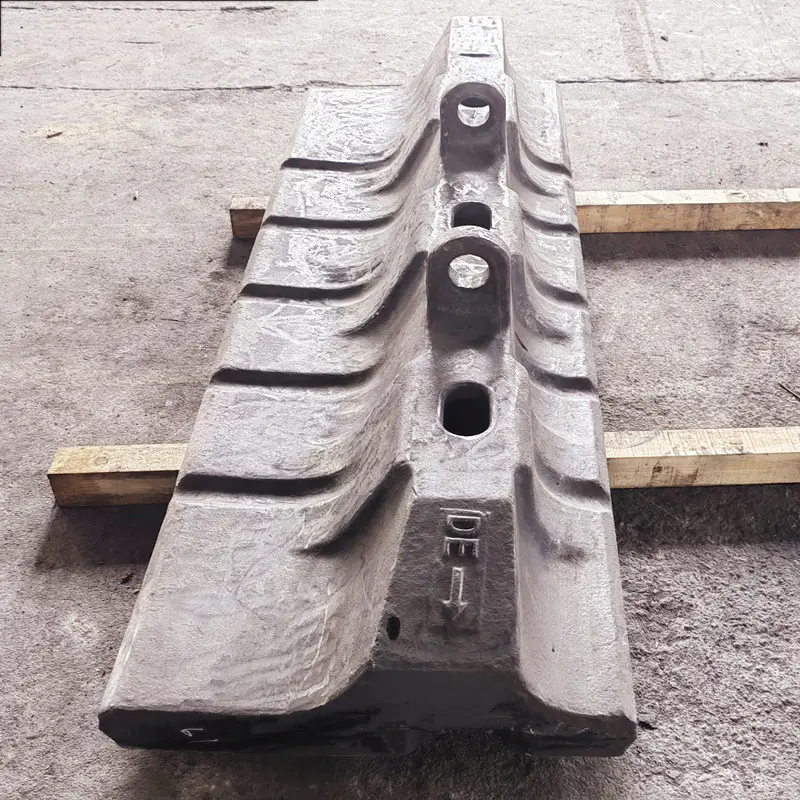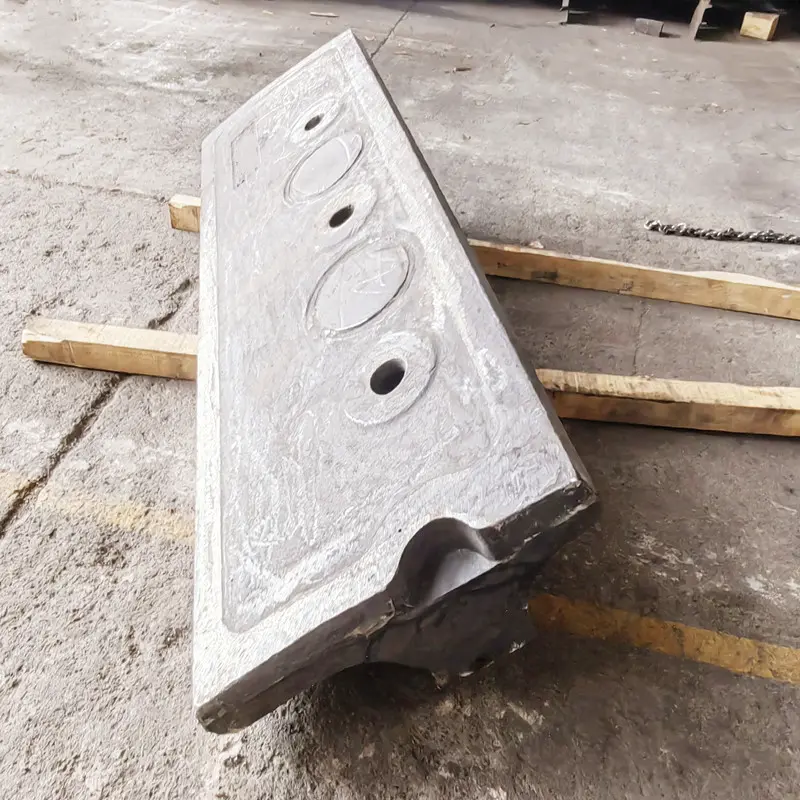To select the appropriate mill liner based on the characteristics of different materials, it is necessary to take into account key factors such as the hardness, toughness and grinding environment of the materials, and match the material, structure and surface design of the liner. The following is the specific selection logic and reference examples:
High-hardness brittle materials (such as granite, quartz sand, iron ore)
The Mohs hardness of this type of material is greater than 6. During grinding, impact crushing is the main method, which places extremely high demands on the wear resistance and impact resistance of the liner.
Material selection: High manganese steel (Mn13Cr2) or bimetallic composite liner plates (with low alloy steel as the base material and high chromium cast iron surfacing on the working surface) are preferred. High manganese steel will rapidly harden on its surface when subjected to strong impacts (hardness increases from HB200 to HB500), and it can withstand high-frequency impacts without breaking easily. Bimetallic liners combine the toughness of the base material with the high wear resistance of the surface layer, making them suitable for handling materials containing hard points such as quartz.
Structural design: It adopts a wavy or convex prism surface, with a lifting bar height of 80-100mm, guiding the grinding medium (steel balls) to form a “throwing – impact” movement, enhancing the crushing force. For instance, in granite grinding, the wavy high manganese steel liner can increase the proportion of -200 mesh particles by 15%, and the wear rate of the liner can be controlled within 0.05mm per hour.

Medium and low hardness and toughness materials (such as clay, talcum powder, graphite)
This type of material has a relatively low hardness (Mohs hardness 2-5), but it is highly resilient. During grinding, extrusion and shearing should be the main methods to avoid particle agglomeration caused by excessive impact.
Material selection: High-chromium cast iron (Cr15Mo3) liners are more suitable. Their hardness reaches HRC55-60, and their resistance to abrasive wear is 50% higher than that of high manganese steel. They can cut tough fibers through continuous extrusion. In talcum powder grinding, high-chromium cast iron liners can keep the particle size deviation of the product within ±1μm.
Structural design: It adopts a stepped or planar surface with fine grooves, with a lifting bar height of 40-60mm, guiding the grinding medium to perform a “rolling – squeezing” movement. The stepped design can extend the residence time of materials in the grinding zone, ensuring that tough particles are fully sheared and refined.
Highly corrosive or wet materials (such as cyanide slurry from gold mines, salts, and raw materials for fertilizers)
This type of material contains acidic or alkaline components or moisture (humidity > 80%). It is necessary to prevent the liner from rusting and contaminating the material, and at the same time reduce the adhesion of the material.
Material selection: Rubber liners (Shore hardness 60-70A) or 316 stainless steel liners are the preferred choices. Rubber liners are resistant to acid and alkali corrosion and have a smooth surface that is not prone to material adhesion. In the wet grinding of gold mines, they can reduce the mechanical loss of gold particles caused by impact and increase the gold recovery rate by 1-2 percentage points. 316 stainless steel liners are suitable for food-grade or highly corrosive scenarios (such as fertilizer production), can withstand acidic and alkaline environments with pH values ranging from 2 to 12, and meet FDA hygiene standards.
Structural design: The surface adopts a smooth arc or shallow groove design to reduce material retention. For instance, in salt wet grinding, arc-shaped rubber liners can reduce the adhesion rate of materials on the surface of the liners, thereby increasing the grinding efficiency by 20%.
Fine grinding or materials with high purity requirements (such as ceramic raw materials, electronic-grade silicon powder, pharmaceutical intermediates)
This type of material requires control of grinding contamination and demands uniform product particle size (such as D50≤5μm), which imposes strict requirements on the cleanliness of the liner and grinding accuracy.
Material selection: Ceramic liner (Al₂O₃ content > 92%) or non-magnetic steel liner. Ceramic liners have high hardness (Mohs hardness 9) and no metal impurities. In the grinding of electronic-grade silicon powder, iron contamination (iron content < 0.001%) can be avoided. Non-magnetic steel liners (with magnetic permeability < 1.01) are suitable for grinding magnetic materials and preventing magnetic field interference.
Structural design: It adopts a smooth parabolic or hemispherical structure, combined with a surface texture of micron-level precision (such as laser-engraved shallow grooves), guiding the material to form a spiral upward grinding trajectory to ensure uniform force distribution on the particles. In the grinding of ceramic glazes, ceramic liners can achieve a product fineness of D90=2μm, and the particle size distribution span is less than 2.0.

High-temperature materials (such as cement clinker, metallurgical slag
When grinding this type of material, the temperature is above 100℃, and the liner needs to be able to withstand high-temperature oxidation and thermal shock.
Material selection: Heat-resistant steel (such as Cr25Ni20) liners, which can maintain high hardness (HB200 and above) and oxidation resistance above 600℃, avoiding softening and wear of the liners due to high temperatures. In the grinding of cement clinker, the service life of heat-resistant steel liners is more than twice that of ordinary high manganese steel.
Structural design: It adopts a ventilation and heat dissipation type structure. The liner is reserved with heat dissipation holes or has built-in heat dissipation channels to reduce the working temperature and minimize liner cracking caused by thermal stress.
In conclusion, the core of selecting mill liners lies in the matching of “material characteristics – liner performance” : for high-hardness materials, impact resistance and wear resistance are emphasized; for tough materials, shear and extrusion are emphasized; for corrosive materials, corrosion resistance and anti-sticking are emphasized; and for fine materials, cleanliness and precision are emphasized. Based on the type of grinding media and equipment specifications in specific production scenarios, the selection can be further optimized to achieve a balance between efficiency and cost.
Post time: Jul-21-2025
